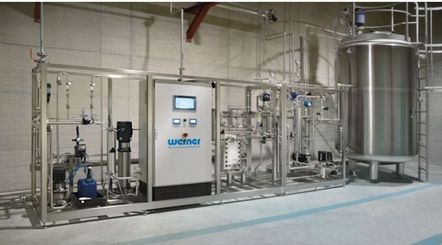Introduction:
In the intricate world of pharmaceuticals, the quality of water used plays a crucial role in ensuring product safety and efficacy. Understanding the diverse grades of water and implementing a robust Pharmaceutical Water System is vital.

Different Grades of Water:
Different grades of water quality are required depending on the route of administration of the pharmaceutical products. Other sources of guidance about deferent grades of water can be found in pharmacopoeias and related documents.WHO TRS 970 Annex 2- 1.2.4
Bulk Purified Water (BPW):
Bulk purified water (BPW) should be prepared from a drinking-water source as a minimum-quality feed-water. It should meet the relevant pharmacopeial specifications for chemical and microbiological purity with appropriate action and alert limits.
It should also be protected from recontamination and microbial proliferation. BPW may be prepared by a combination of reverse osmosis (RO) /electro-deionization (EDI) .What's noteworthy is the reliance on analytical technologies like Total Organic Carbon (TOC) and conductivity for quality assessment. WHO TRS 970 Annex 2 - 3.3.1Bulk Water for Injections (BWFI):
BWFI is not sterile water and is not a final dosage form. It is an intermediate, bulk product and suitable to be used as an ingredient during formulation, BWFI is the highest quality of pharmacopoeial WPU, Bulk water for injections (BWFI) should be prepared from drinking-water (usually with further treatment) or purified water as a minimum-quality feed water.
Certain pharmacopoeias place constraints upon the permitted purification techniques as part of the specification of the BWFI, The International Pharmacopoeia and the European Pharmacopoeia, for example, allow only distillation as the final purification step. WHO TRS 970 Annex 2 - 3.5
Production of water for injection by means other than distillation such as deionization, electro-deionization, nanofiltration, ultrafiltration, water softening, descaling, prefiltration, degasification, and ultraviolet treatment, along with other techniques, may be considered in conjunction with a single- or double-pass reverse osmosis system. WHO TRS 1025 Annex 3 6.6
Design Considerations:
Measures should be taken to minimize the risk of presence of particulates, microbial contamination/proliferation, and endotoxin/pyrogen (e.g., sloping of piping to provide complete drainage and the avoidance of dead legs. EU GMP Eudralex Annex 1 - 6.7
the materials selected must be appropriate, the method of jointing must be carefully controlled and all fittings and components must be compatible with the pipework used. Appropriate sanitary specification plastics and stainless-steel materials are acceptable for WPU systems.
When stainless steel is used it should be at least grade 316. In general 316L or a higher grade of stainless steel is used. WHO TRS 970 Annex 2- 6.2.2
Deadlegs in the pipework should be minimized through appropriate design, and as a guide should not significantly exceed three times the branch diameter as measured from the ID pipe wall to Centre line of the point-of-use valve where significant stagnation potential exists. WHO TRS 970 Annex 2- 6.5.4Water flow should remain turbulent through the pipes in water distribution systems to minimize the risk of microbial adhesion, and subsequent biofilm formation. The flow rate should be established during qualification and be routinely monitored.EU GMP Eudralex Annex 1- 6.9
Commissioning and Qualification:
The commissioning work should include setting to work, system set-up, controls, loop tuning and recording of all system performance parameters. WHO TRS 970 Annex 2-7.1.2
BPW, and BWFI systems are all considered to be direct impact, quality critical systems that should be qualified. The qualification should follow the validation convention of design review or design qualification (DQ), IQ, OQ, and PQ. WHO TRS 970 Annex 2 - 7.2
Continuous Monitoring and Trend Analysis:
Regular ongoing chemical and microbial monitoring of water systems should be performed to ensure that the water continues to meet compendial expectations. Alert levels should be based on the initial qualification data and thereafter periodically reassessed.
Sample plans should be based on the qualification data, should consider the potential worst case sampling locations and should ensure that at least one representative sample is included every day of the water that is used for manufacturing processes.EU GMP Eudralex Annex 1 - 6.13
Monitoring data should be subject to trend analysis (trending should typically, be within 2 sigma). Suitable alert and action levels should be established based on historical reported data. WHO TRS 970 Annex 2- 7.3
Preventing Microbial Contamination:
To mitigate microbial contamination risks, measures such as ultraviolet radiation, system heating, periodic chemical sanitization, and routine testing are implemented. The choice of materials, system configuration, and temperature control play pivotal roles in preventing the ingress and proliferation of contaminant.
System Maintenance:
A preventive maintenance program should be established to ensure that the water system remains in a state of control. The program should include:
(1)procedures for operating the system.(2) monitoring programs for critical quality attributes and operating conditions including calibration of critical instruments,
(3) schedule for periodic sanitization.
(4) preventive maintenance of components, and
(5) control of changes to the mechanical system and to operating conditions.
Monitoring Program- Critical quality attributes and operating parameters should be documented and monitored. USP Ch. 1231- operation maintenance and control
Conclusion:
In the realm of pharmaceutical water systems, adherence to GMP standards is non-negotiable. By understanding and implementing the guidelines for different grades of water, designing robust systems, and ensuring continuous monitoring and maintenance, pharmaceutical companies can uphold the highest standards of water quality. This commitment is not just a regulatory necessity; it's a fundamental aspect of safeguarding the health and well-being of end-users.
References
1. Volume 4 EU , Annex 1 Manufacture of Sterile Medicinal Products
2. WHO Technical Report Series, No WHO TRS 970 Annex 2, WHO good manufacturing practices: water for
pharmaceutical use
3. WHO Technical Report Series, No WHO TRS 1025 Annex 3, Production of water for injection by means other than
distillation
4. USP, General chapters Ch. 1231 , WATER FOR PHARMACEUTICAL PURPOSES